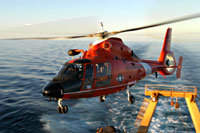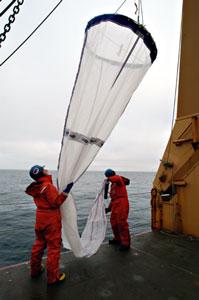 |
Daily Update
Calendar
Dispatch 14 - September 23, 2003
By C. A. Linder
Weather conditions: Overcast skies, 15 kt winds, 1-2 ft seas,
air temperature 30°F
Lights and Lobsters
I stayed up late last night - very late. How can you sleep when
green ribbons of light are dancing across the clear night sky? The
aurora borealis visited us last night and put on an incredible show.
Starting at about midnight as a pale green glow, the aurora grew
into a vast river of light arcing from horizon to horizon. The warm
air (about 37°F) and light breeze made it the perfect aurora-watching
night. I watched for hours as the ghostly tendrils snaked across
the sky, finally fading into a pale mist.
A perfectly clear, calm dawn was a
welcome sight to Jim Johnson and David Leech. Since their mooring
work was complete, they were catching
rides back to civilization on the ship's helicopter. Jim Johnson
will be returning to his home in Seattle, but I don't think he'll
even be unpacking - he is headed to another mooring cruise in a
few short days! ... and David has some very rambunctious dogs that
are waiting for a long walk in Seward, Alaska. We will miss their
helping hands and their great company. As the HH-65A's rotor blades
began to spin on the flight deck, we passed on our wishes for a
happy journey, and moments later they were lifting
off, headed for the small Alaskan town of Wainwright.
 |
 |
| The HH-65A Dolphin
helicopter takes off for Wainwright, Alaska. |
Click
to enlarge
|
 |
| Carin Ashjian (left) and Marine Science Technician Daniel Gaona (right) deploy the ring net off the fantail. |
| Click
to enlarge |
This afternoon we tested out Carin Ashjian's ring
net system. This is one oceanographic tool that is easy to explain!
All we do is dip this net into the water
and bring it back up. Then we look at what
we caught! The gooey substance that looks like applesauce is composed
mainly of microscopic marine plants called phytoplankton. Carin was
surprised at how much phytoplankton came up in this net tow - usually
the concentration is much lower at this time of year. As we sifted
through the 'sauce,' we looked for tiny marine crustaceans called
copepods. They look like tiny lobsters,
and they feed on phytoplankton and other copepods in the ocean. They
are an important part of the food web in the Arctic Ocean, and are
a key food source for the mighty bowhead whales that migrate through
the Arctic.
I have received some questions from Mrs. Cadwell's 5th grade students
at Varnum Brook Elementary School in Pepperell, Massachusetts.
Question from Kevin: How fast can the Healy go?
Answer: Hi Kevin, the Healy can go 18 knots
at top speed. What's a knot, you might be asking? A knot is a nautical
mile per hour. We use nautical miles and knots at sea because one
nautical mile is equivalent to one minute of latitude - that makes
it easy to measure distances on charts. So what's a nautical mile?
A nautical mile is 2,025 yards, as opposed to a statute (regular,
everyday) mile, which is 1,760 yards. So, knowing that, can you figure
out how fast the Healy can go in miles per hour? I'll put
the answer in tomorrow's dispatch.
Question from Marlayna: How far have you traveled
since the day you left? Could you show us your path so we can look
at it?
Answer: Marlayna, to view our most recent position
click here. Due to security requirements
the map is two days old, but it gives you an idea of where we have
been. We have already traveled over 1,600 miles (statue miles). That's
roughly halfway across the United States! We are about one third of
the way done with the cruise, so we have a lot more traveling left
to do...
Today's transit was a welcome break from the intense CTD surveying
we have been doing in the Chukchi Sea. Tonight we will arrive at the
deepest station of the WHOI mooring
array and Carin Ashjian will do some net tows at the mooring locations.
She is doing this for a very important reason. The WHOI moorings have
been (hopefully) collecting data since last year. One of those instruments
is an Acoustic Doppler Current Profiler
(ADCP). It measures currents by bouncing sound waves off of small
particles in the water column. Some of those particles are tiny copepods!
So, in addition to measuring the currents, the ADCP can also give
you an estimate of how many copepods there are. Carin's net tows will
provide an important "ground truth" to the ADCP data. She
will compare the number of copepods in the net to the number that
the ADCP measures, and using that data she will be able to make assumptions
about the numbers the ADCP has measured throughout the year. After
the night net tows, John Kemp and Ryan Schrawder will start pulling
up the WHOI mooring array, starting right after breakfast.
 Previous
Dispatch Next Dispatch Previous
Dispatch Next Dispatch

Back to
Calendar
|




